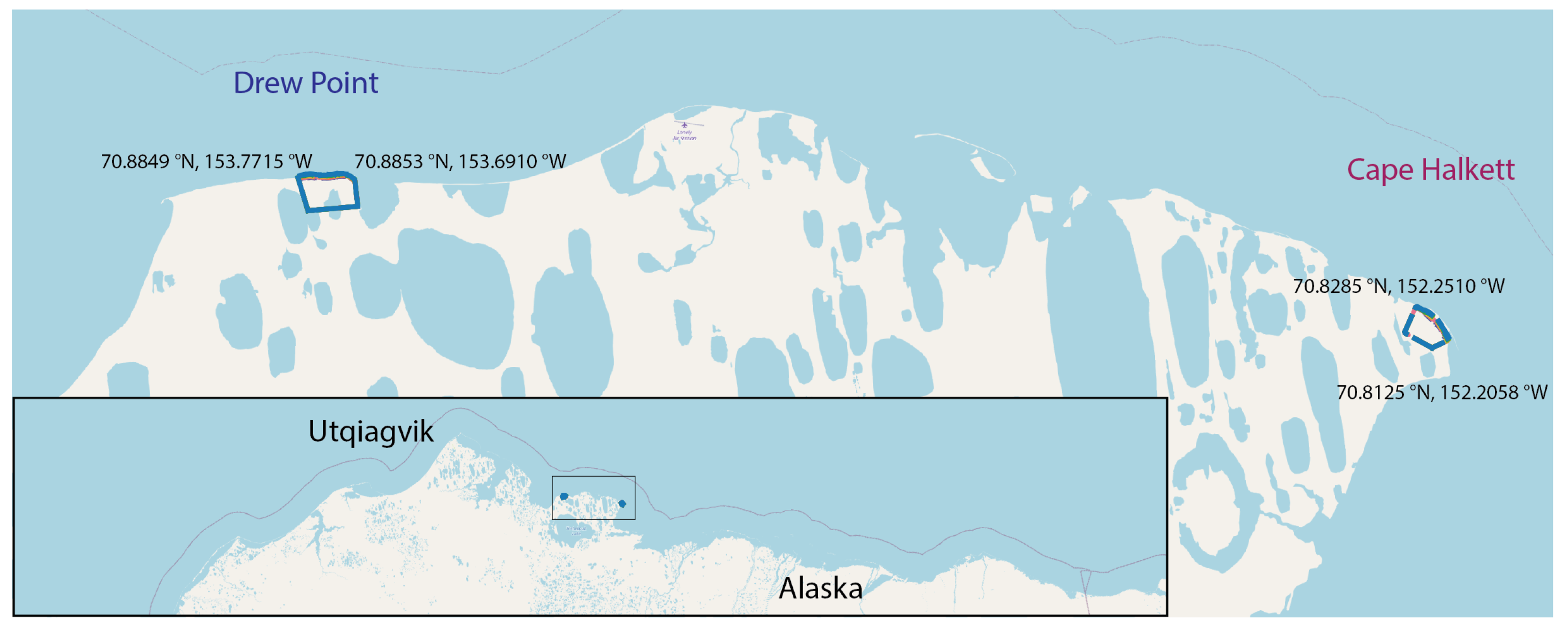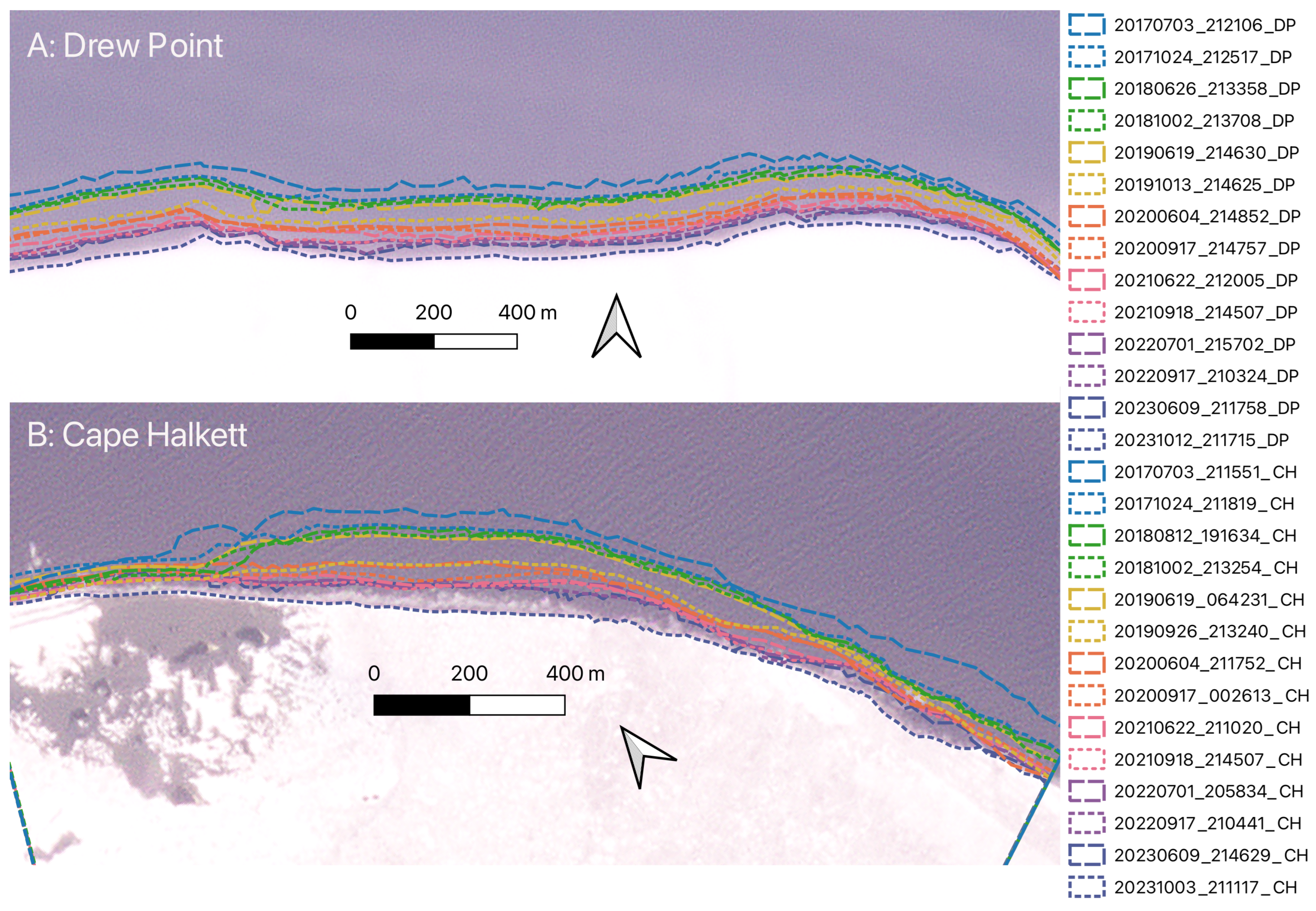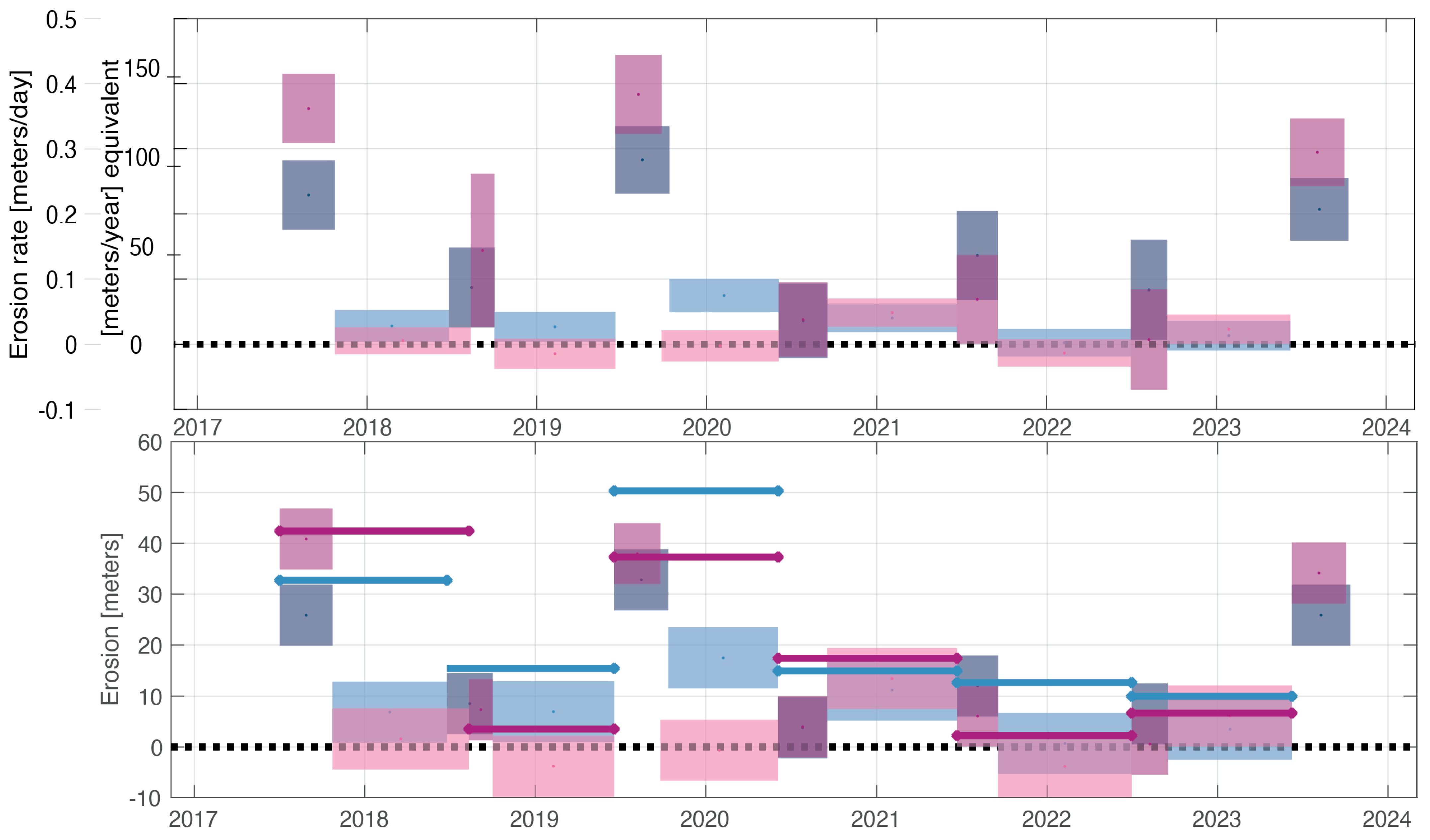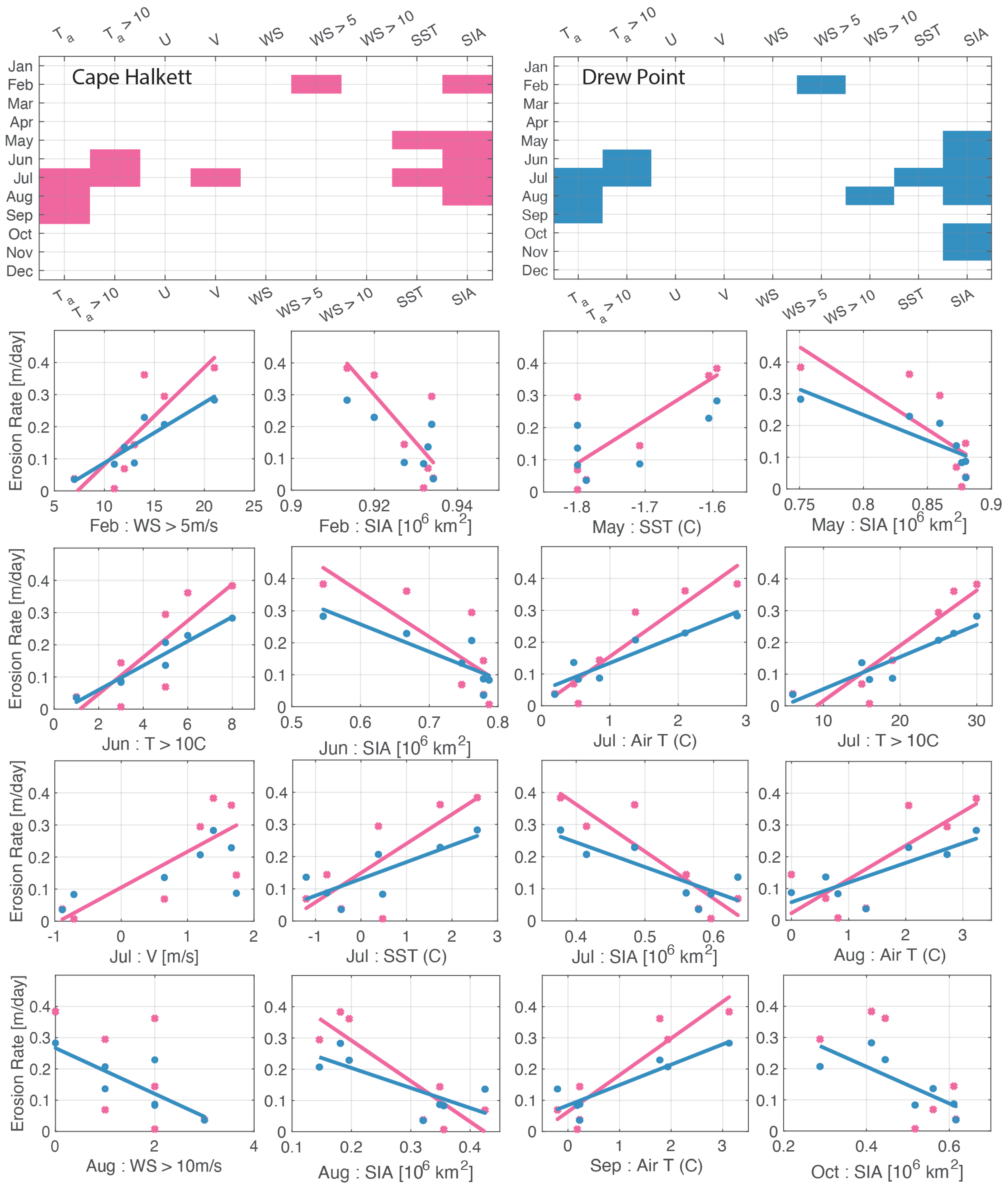Seasonal Coastal Erosion Rates Calculated from PlanetScope Imagery in Arctic Alaska
Abstract
:1. Introduction
2. Materials and Methods
2.1. Study Sites
2.2. PlanetScope Imagery Analysis
2.3. Other Environmental Parameters
3. Results
3.1. Measured Erosion Rates
3.2. Correlation with Environmental Parameters
4. Discussion
Supplementary Materials
Author Contributions
Funding
Institutional Review Board Statement
Informed Consent Statement
Data Availability Statement
Acknowledgments
Conflicts of Interest
References
- Hino, M.; Field, C.B.; Mach, K.J. Managed retreat as a response to natural hazard risk. Nat. Clim. Chang. 2017, 7, 364–370. [Google Scholar] [CrossRef]
- MacDougall, A.H.; Avis, C.A.; Weaver, A.J. Significant contribution to climate warming from the permafrost carbon feedback. Nat. Geosci. 2012, 5, 719–721. [Google Scholar] [CrossRef]
- Johannessen, O.M.; Bengtsson, L.; Miles, M.W.; Kuzmina, S.I.; Semenov, V.A.; Alekseev, G.V.; Nagurnyi, A.P.; Zakharov, V.F.; Bobylev, L.P.; Pettersson, L.H.; et al. Arctic climate change: Observed and modelled temperature and sea-ice variability. Tellus A Dyn. Meteorol. Oceanogr. 2004, 56, 328–341. [Google Scholar] [CrossRef]
- Overeem, I.; Anderson, R.S.; Wobus, C.W.; Clow, G.D.; Urban, F.E.; Matell, N. Sea ice loss enhances wave action at the Arctic coast. Geophys. Res. Lett. 2011, 38, 1–6. [Google Scholar] [CrossRef]
- Nicholls, R.J.; Marinova, N.; Lowe, J.A.; Brown, S.; Vellinga, P.; De Gusmao, D.; Hinkel, J.; Tol, R.S. Sea-level rise and its possible impacts given a `beyond 4 C world’ in the twenty-first century. Philos. Trans. R. Soc. A Math. Phys. Eng. Sci. 2011, 369, 161–181. [Google Scholar] [CrossRef]
- Casas-Prat, M.; Wang, X.L. Projections of Extreme Ocean Waves in the Arctic and Potential Implications for Coastal Inundation and Erosion. J. Geophys. Res. Ocean. 2020, 125, 1–18. [Google Scholar] [CrossRef]
- Lantuit, H.; Overduin, P.P.; Couture, N.; Wetterich, S.; Aré, F.; Atkinson, D.; Brown, J.; Cherkashov, G.; Drozdov, D.; Forbes, D.L.; et al. The Arctic coastal dynamics database: A new classification scheme and statistics on Arctic permafrost coastlines. Estuaries Coasts 2012, 35, 383–400. [Google Scholar] [CrossRef]
- Gibbs, A.E.; Richmond, B.M. National Assessment of Shoreline Change: Summary Statistics for Updated Vector Shorelines and Associated Shoreline Change Data for the North Coast of Alaska, US-Canadian Border to Icy Cape; US Department of the Interior, Geological Survey: Reston, VA, USA, 2017.
- Gibbs, A.E.; Snyder, A.G.; Richmond, B.M. National Assessment of Shoreline Change—Historical Shoreline Change along the North Coast of Alaska, Icy Cape to Cape Prince of Wales; Technical Report; US Geological Survey: Reston, VA, USA, 2019.
- Lantuit, H.; Pollard, W. Fifty years of coastal erosion and retrogressive thaw slump activity on Herschel Island, southern Beaufort Sea, Yukon Territory, Canada. Geomorphology 2008, 95, 84–102. [Google Scholar] [CrossRef]
- Ogorodov, S.; Aleksyutina, D.; Baranskaya, A.; Shabanova, N.; Shilova, O. Coastal erosion of the Russian Arctic: An overview. J. Coast. Res. 2020, 95, 599–604. [Google Scholar] [CrossRef]
- Jones, B.M.; Arp, C.D.; Jorgenson, M.T.; Hinkel, K.M.; Schmutz, J.A.; Flint, P.L. Increase in the rate and uniformity of coastline erosion in Arctic Alaska. Geophys. Res. Lett. 2009, 36. [Google Scholar] [CrossRef]
- Mars, J.; Houseknecht, D. Quantitative remote sensing study indicates doubling of coastal erosion rate in past 50 yr along a segment of the Arctic coast of Alaska. Geology 2007, 35, 583–586. [Google Scholar] [CrossRef]
- Casas-Prat, M.; Wang, X.L. Sea ice retreat contributes to projected increases in extreme Arctic Ocean surface waves. Geophys. Res. Lett. 2020, 47, e2020GL088100. [Google Scholar] [CrossRef]
- Are, F. Thermal abrasion of sea coasts (parts I and II). Polar Geogr. Geol. 1988, 12, 1–157. [Google Scholar] [CrossRef]
- Stroeve, J.; Serreze, M.; Drobot, S.; Gearheard, S.; Holland, M.; Maslanik, J.; Meier, W.; Scambos, T. Arctic sea ice extent plummets in 2007. Eos Trans. Am. Geophys. Union 2008, 89, 13–14. [Google Scholar] [CrossRef]
- Richter-Menge, J.; Overland, J.E. (Eds.) Arctic Report Card 2010; National Oceanic and Atmospheric Administration: Washington, DC, USA, 2010. Available online: http://www.arctic.noaa.gov/reportcard (accessed on 18 June 2024).
- Steele, M.; Ermold, W.; Zhang, J. Arctic Ocean surface warming trends over the past 100 years. Geophys. Res. Lett. 2008, 35, 1–6. [Google Scholar] [CrossRef]
- Brown, J.; Romanovsky, V.E. Report from the International Permafrost Association: State of permafrost in the first decade of the 21st century. Permafr. Periglac. Process. 2008, 19, 255–260. [Google Scholar] [CrossRef]
- Jorgenson, M.T.; Shur, Y.L.; Pullman, E.R. Abrupt increase in permafrost degradation in Arctic Alaska. Geophys. Res. Lett. 2006, 33, 1–4. [Google Scholar] [CrossRef]
- Jorgenson, M.; Yoshikawa, K.; Kanevskiy, M.; Shur, Y.; Romanovsky, V.; Marchenko, S.; Grosse, G.; Brown, J.; Jones, B. Permafrost characteristics of Alaska. In Proceedings of the Ninth International Conference on Permafrost, Fairbanks, AK, USA, 29 June–3 July 2008; University of Alaska Fairbanks: Fairbanks, AK, USA, 2008; Volume 3, pp. 121–122. [Google Scholar]
- IPCC. Contribution of Working Groups I, II and III to the Fourth Assessment Report of the Intergovernmental Panel on Climate Change. In Climate Change 2007: Synthesis Report; Core Writing Team, Pachauri, R.K., Reisinger, A., Eds.; IPCC: Geneva, Switzerland, 2007. [Google Scholar]
- Wobus, C.; Anderson, R.; Overeem, I.; Matell, N.; Clow, G.; Urban, F. Thermal erosion of a permafrost coastline: Improving process-based models using time-lapse photography. Arctic Antarct. Alp. Res. 2011, 43, 474–484. [Google Scholar] [CrossRef]
- Dallimore, S.R.; Wolfe, S.A.; Solomon, S.M. Influence of ground ice and permafrost on coastal evolution, Richards Island, Beaufort Sea coast, NWT. Can. J. Earth Sci. 1996, 33, 664–675. [Google Scholar] [CrossRef]
- Benumof, B.T.; Storlazzi, C.D.; Seymour, R.J.; Griggs, G.B. The relationship between incident wave energy and seacliff erosion rates: San Diego County, California. J. Coast. Res. 2000, 16, 1162–1178. [Google Scholar]
- Atkinson, D.E. Observed storminess patterns and trends in the circum-Arctic coastal regime. Geo-Mar. Lett. 2005, 25, 98–109. [Google Scholar] [CrossRef]
- Ravens, T.M.; Jones, B.M.; Zhang, J.; Arp, C.D.; Schmutz, J.A. Process-based coastal erosion modeling for drew point, North Slope, Alaska. J. Waterw. Port Coastal Ocean. Eng. 2012, 138, 122–130. [Google Scholar] [CrossRef]
- Mason, O.K.; Jordan, J.W. Heightened North Pacific storminess during synchronous late Holocene erosion of Northwest Alaska beach ridges. Quat. Res. 1993, 40, 55–69. [Google Scholar] [CrossRef]
- Sturtevant, P.M.; Lestak, L.R.; Manley, W.F.; Maslanik, J.A. Coastal erosion along the Chukchi coast due to an extreme storm event at Barrow, Alaska. Arctic Coastal Dynamics, Report of an International Workshop. Available online: https://www.researchgate.net/publication/242132406_COASTAL_EROSION_ALONG_THE_CHUKCHI_COAST_DUE_TO_AN_EXTREME_STORM_EVENT_AT_BARROW_ALASKA (accessed on 18 June 2024).
- Radosavljevic, B.; Lantuit, H.; Pollard, W.; Overduin, P.; Couture, N.; Sachs, T.; Helm, V.; Fritz, M. Erosion and flooding—Threats to coastal infrastructure in the Arctic: A case study from Herschel Island, Yukon Territory, Canada. Estuaries Coasts 2016, 39, 900–915. [Google Scholar] [CrossRef]
- Barnhart, K.R.; Overeem, I.; Anderson, R.S. The effect of changing sea ice on the physical vulnerability of Arctic coasts. Cryosphere 2014, 8, 1777–1799. [Google Scholar] [CrossRef]
- Crawford, A.D.; Lukovich, J.V.; McCrystall, M.R.; Stroeve, J.C.; Barber, D.G. Reduced sea ice enhances intensification of winter storms over the Arctic Ocean. J. Clim. 2022, 35, 3353–3370. [Google Scholar] [CrossRef]
- Fang, Z.; Freeman, P.T.; Field, C.B.; Mach, K.J. Reduced sea ice protection period increases storm exposure in Kivalina, Alaska. Arct. Sci. 2018, 4, 525–537. [Google Scholar] [CrossRef]
- Stroeve, J.; Markus, T.; Boisvert, L.; Miller, J.; Barrett, A. Changes in Arctic melt season and implications for sea ice loss. Geophys. Res. Lett. 2014, 41, 1216–1225. [Google Scholar] [CrossRef]
- Barrow Atmospheric Baseline Observatory. NOAA Global Monitoring Observatory: Wind Speed In Situ Meteorology Data, 1973–2024. Available online: https://gml.noaa.gov/dv/iadv/graph.php?code=BRW&program=met&type=ts (accessed on 25 May 2024).
- Bliss, A.C.; Steele, M.; Peng, G.; Meier, W.N.; Dickinson, S. Regional variability of Arctic sea ice seasonal change climate indicators from a passive microwave climate data record. Environ. Res. Lett. 2019, 14, 045003. [Google Scholar] [CrossRef]
- Cavalieri, D.J.; Parkinson, C.L. Arctic sea ice variability and trends, 1979–2010. Cryosphere 2012, 6, 881–889. [Google Scholar] [CrossRef]
- Guégan, E.B.; Christiansen, H.H. Seasonal Arctic coastal bluff dynamics in Adventfjorden, Svalbard. Permafr. Periglac. Process. 2017, 28, 18–31. [Google Scholar] [CrossRef]
- Vos, K.; Harley, M.D.; Splinter, K.D.; Simmons, J.A.; Turner, I.L. Sub-annual to multi-decadal shoreline variability from publicly available satellite imagery. Coast. Eng. 2019, 150, 160–174. [Google Scholar] [CrossRef]
- Specht, M.; Specht, C.; Lewicka, O.; Makar, A.; Burdziakowski, P.; Dąbrowski, P. Study on the Coastline Evolution in Sopot (2008–2018) Based on Landsat Satellite Imagery. J. Mar. Sci. Eng. 2020, 8, 464. [Google Scholar] [CrossRef]
- Esmail, M.; Mahmod, W.E.; Fath, H. Assessment and prediction of shoreline change using multi-temporal satellite images and statistics: Case study of Damietta coast, Egypt. Appl. Ocean. Res. 2019, 82, 274–282. [Google Scholar] [CrossRef]
- USGS. What Are the Band Designations for the Landsat Satellites? United States Geological Survey: Reston, VA, USA, 2022.
- Tatem, A.J.; Goetz, S.J.; Hay, S.I. Fifty years of earth observation satellites: Views from above have lead to countless advances on the ground in both scientific knowledge and daily life. Am. Sci. 2008, 96, 390. [Google Scholar] [CrossRef]
- Frazier, A.E.; Hemingway, B.L. A Technical Review of Planet Smallsat Data: Practical Considerations for Processing and Using PlanetScope Imagery. Remote Sens. 2021, 13, 3930. [Google Scholar] [CrossRef]
- Planet Labs PBC. Planet Application Program Interface: In Space for Life on Earth, 2017–2023; Planet Labs PBC: San Francisco, CA, USA, 2024; Available online: https://api.planet.com (accessed on 25 May 2024).
- Jones, B.M.; Farquharson, L.M.; Baughman, C.A.; Buzard, R.M.; Arp, C.D.; Grosse, G.; Bull, D.L.; Günther, F.; Nitze, I.; Urban, F.; et al. A decade of remotely sensed observations highlight complex processes linked to coastal permafrost bluff erosion in the Arctic. Environ. Res. Lett. 2018, 13, 115001. [Google Scholar] [CrossRef]
- Hertz, N. Alaska Gov. Walker declares disaster after costly fall storm on North Slope. Anchorage Daily News, 15 November 2017. [Google Scholar]
- QGIS.org. QGIS Geographic Information System. 2022. Available online: https://qgis.org (accessed on 18 June 2024).
- NOAA. Tides and Currents: Tide Predictions 9095048 Point Barrow, AK; National Oceanic and Atmospheric Administration: Washington, DC, USA, 2024. Available online: https://tidesandcurrents.noaa.gov/noaatidepredictions.html?id=9495048&units=metric&bdate=20240301&edate=20240331&timezone=LST/LDT&clock=12hour&datum=MLLW&interval=hilo&action=data (accessed on 18 June 2024).
- GMAO. MERRA-2 instM_3d_ana_Np: 3d, Monthly Mean, Instantaneous, Pressure-Level, Analysis, Analyzed Meteorological Fields V5.12.4 (M2IMNPANA), 2m Air Temperature, 10m u-wind, 10m v-wind; Global Modeling and Assimilation Office: Greenbelt, MD, USA, 2015. [Google Scholar] [CrossRef]
- NOAA-ESRL. Web-Based Reanalysis Intercomparison Tool: Monthly Maps; Physical Sciences Laboratory: Boulder, CO, USA, 2024. Available online: https://psl.noaa.gov/data/atmoswrit/map/ (accessed on 18 June 2024).
- Fetterer, F.; Knowles, K.; Meier, W.N.; Savoie, M.; Windnagel, A.K. Sea Ice Index, Version 3; National Snow and Ice Data Center: Boulder, CA, USA, 2017. [Google Scholar] [CrossRef]
- Kalnay, E.; Kanamitsu, M.; Kistler, R.; Collins, W.; Deaven, D.; Gandin, L.; Iredell, M.; Saha, S.; White, G.; Woollen, J.; et al. The NCEP/NCAR 40-year reanalysis project. Bull. Am. Meteorol. Soc. 2018, 77, 437–472. [Google Scholar] [CrossRef]
- NOAA-ESRL. Access and Analyze Daily Weather/Climate Time Series; Physical Sciences Laboratory: Boulder, CO, USA, 2024. Available online: https://psl.noaa.gov/data/timeseries/daily/ (accessed on 18 June 2024).
- Mahoney, A.; Eicken, H.; Gaylord, A.G.; Shapiro, L. Alaska landfast sea ice: Links with bathymetry and atmospheric circulation. J. Geophys. Res. Ocean. 2007, 112, 1–18. [Google Scholar] [CrossRef]
- Jahn, A.; Holland, M.M.; Kay, J.E. Projections of an ice-free Arctic Ocean. Nat. Rev. Earth Environ. 2024, 5, 164–176. [Google Scholar] [CrossRef]
- Overland, J.E.; Wang, M.; Walsh, J.E.; Stroeve, J.C. Future Arctic climate changes: Adaptation and mitigation time scales. Earth Future 2014, 2, 68–74. [Google Scholar] [CrossRef]





Disclaimer/Publisher’s Note: The statements, opinions and data contained in all publications are solely those of the individual author(s) and contributor(s) and not of MDPI and/or the editor(s). MDPI and/or the editor(s) disclaim responsibility for any injury to people or property resulting from any ideas, methods, instructions or products referred to in the content. |
© 2024 by the authors. Licensee MDPI, Basel, Switzerland. This article is an open access article distributed under the terms and conditions of the Creative Commons Attribution (CC BY) license (https://creativecommons.org/licenses/by/4.0/).
Share and Cite
Cassidy, G.; Wiseman, M.; Lange, K.; Eilers, C.; Bradley, A. Seasonal Coastal Erosion Rates Calculated from PlanetScope Imagery in Arctic Alaska. Remote Sens. 2024, 16, 2365. https://doi.org/10.3390/rs16132365
Cassidy G, Wiseman M, Lange K, Eilers C, Bradley A. Seasonal Coastal Erosion Rates Calculated from PlanetScope Imagery in Arctic Alaska. Remote Sensing. 2024; 16(13):2365. https://doi.org/10.3390/rs16132365
Chicago/Turabian StyleCassidy, Galen, Matthew Wiseman, Kennedy Lange, Claire Eilers, and Alice Bradley. 2024. "Seasonal Coastal Erosion Rates Calculated from PlanetScope Imagery in Arctic Alaska" Remote Sensing 16, no. 13: 2365. https://doi.org/10.3390/rs16132365




